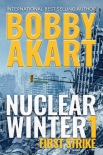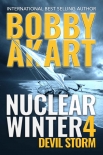Nuclear Winter First Strike Bobby Akart (children's ebooks free online .txt) 📖

- Author: Bobby Akart
Book online «Nuclear Winter First Strike Bobby Akart (children's ebooks free online .txt) 📖». Author Bobby Akart
Hank glanced toward the bar and saw that Mike was chatting with the bartender. “Well, I have another challenge. However, this one is for you. I need you and Mike to agree to move back to Driftwood Key for a while. And I’m talking about tomorrow, if not tonight.”
Chapter Thirty-Four
Tuesday, October 22
Oval Office
The White House
The White House was bustling with activity as panicked staffers raced around carrying sealed banker’s boxes with files destined for an undisclosed location. Outside the West Wing, white unmarked box trucks were lined up to accept the cargo. The vast majority of the staffers would be furloughed until further notice as the president prepared to be removed to a safer location, one whose floors, walls and ceilings were impenetrable to a nuclear blast.
While the National Security Agency was not prepared to affirmatively state the U.S. was under an immediate nuclear threat, the combination of the events of the last three days and the saber rattling by the North Koreans was enough to evacuate the Helton administration to a more secure facility.
Since President Truman had been in office, U.S. presidents have had access to fortified bunkers to ride out a nuclear war. If the missiles were in the air, the president would be hustled back into the PEOC. However, it was designed to house only a few people for a very limited time. Another option was Greenbrier in the Blue Ridge Mountains of West Virginia. Formerly a nuclear bunker for Congress, it’s now a tourist attraction but can immediately be repurposed in a state of emergency.
To the north of Washington was Raven Rock in the hills of Southern Pennsylvania. It is mostly dedicated for the military. Peters Mountain, also known as Spy Mountain, was a fortified bunker north of Charlottesville, Virginia, dedicated to America’s intelligence agencies.
The Cheyenne Mountain Complex in Colorado was the most well-known of them all. Built deep within a mountain, it housed NORAD, the North American Aerospace Defense Command, charged with the responsibility of defending America from a nuclear attack.
Today, the president was going to be evacuated as part of the U.S. continuity of government readiness condition known as COGCON 1. In the event of a credible threat of nuclear attack, the Administration and the U.S. government would be relocated to a secure, fully staffed bunker.
His destination was Mount Weather, a mountain peak near Bluemont, Virginia, just fifty miles outside Washington. Run by FEMA, Doomsday City, as it was known, had been activated and kept in a constant state of readiness since the terrorist attacks of 9/11. Mount Weather was built during the throes of the Cold War and was capable of taking a direct hit. It housed the president, his aides, and hundreds of others necessary to operate the government during a time of war.
All of these facilities were designed to ensure continuity of government during an anticipated foreign invasion, nuclear war, electromagnetic pulse attack, or a natural catastrophe of enormous magnitude.
The evacuation was not the president’s idea. He had to defer to the defense department. However, the decision aligned with one that he’d made. He was tired of America living under the thumb of her enemies. Namely, North Korea. If Israel and India could take the bold step of beating back their archenemies, so could he. However, there was more to his decision-making process.
President Helton’s family had experienced the horrors of the Kim regime. In fact, he was surprised nosy reporters or opposition researchers for his political opponents had never picked up on it.
His uncle, the brother of his deceased mother, had joined a humanitarian contingent to visit a disease-stricken village in the western regions of North Korea. Part of Doctors Without Borders, the beloved uncle of the president had been like a father to him growing up. He’d paired with another medical provider, an epidemiologist who happened to be the mother of Secretary of State Carolyn Sanders.
While examining and treating patients in a remote village away from their assigned areas, the two encountered a North Korean security patrol. They were brutally beaten simply because they were Americans. Their mauled corpses were returned to the Doctors Without Borders camp. It was explained to the director of the contingent that criminals had attacked the two and were immediately killed by brave North Korean soldiers.
Nobody ever believed the story. Days later, the group was expelled from the country, and any chance of learning the truth was lost.
President Helton had discovered the commonality with Secretary Sanders many years ago at a political fundraising dinner. They compared notes, comforted one another, and became longtime friends. They also shared a solemn promise. To avenge their loved ones.
When he was elected, the president never imagined he’d have the opportunity to exact his revenge on the murderous regime. He’d laid the groundwork to gain the opportunity by bringing Sanders into his cabinet. Once in office, he learned how the U.S. government worked. In secret. He established a commission of loyalists to find an opportunity, as well as a justification, for wiping Kim Jong Un off the face of the planet.
That opportunity was now.
After clearing the Oval Office, the president retrieved a celebratory cigar he’d planned on smoking following his inauguration. He’d gotten caught up in the moment, and the opportunity, or just the right occasion, never presented itself.
He rolled the glass tube containing the Gurkha Churchill in his fingers. The top was sealed with green wax reminiscent of a Maker’s Mark whisky bottle. The cigar, known as His Majesty’s Reserve, sold for $750 each. A hefty price for a smoke but preferred by elites inside the Beltway and considered one of the most expensive cigars ever made.
He peeled off the seal and retrieved his butane lighter. Earliest man had a fascination with fire. It represented life as well as destruction, the president thought to himself as the hot flame hissed out of the lighter. He became mesmerized by its




Comments (0)